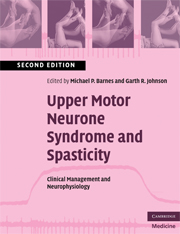Book contents
- Frontmatter
- Contents
- List of Contributors
- Preface to the second edition
- 1 An overview of the clinical management of spasticity
- 2 Neurophysiology of spasticity
- 3 The measurement of spasticity
- 4 Physiotherapy management of spasticity
- 5 Seating and positioning
- 6 Orthoses, splints and casts
- 7 Pharmacological management of spasticity
- 8 Chemical neurolysis in the management of muscle spasticity
- 9 Spasticity and botulinum toxin
- 10 Intrathecal baclofen for the control of spinal and supraspinal spasticity
- 11 Surgical management of spasticity
- 12 Management of spasticity in children
- Index
- References
11 - Surgical management of spasticity
Published online by Cambridge University Press: 22 August 2009
- Frontmatter
- Contents
- List of Contributors
- Preface to the second edition
- 1 An overview of the clinical management of spasticity
- 2 Neurophysiology of spasticity
- 3 The measurement of spasticity
- 4 Physiotherapy management of spasticity
- 5 Seating and positioning
- 6 Orthoses, splints and casts
- 7 Pharmacological management of spasticity
- 8 Chemical neurolysis in the management of muscle spasticity
- 9 Spasticity and botulinum toxin
- 10 Intrathecal baclofen for the control of spinal and supraspinal spasticity
- 11 Surgical management of spasticity
- 12 Management of spasticity in children
- Index
- References
Summary
Introduction
Spasticity is one of the commonest sequelae of neurological diseases. In most patients spasticity is useful in compensating for lost motor strength. Nevertheless, in a significant number of patients it may become excessive and harmful, leading to further functional losses. When not controllable by physical therapy, medications and/or botulinum toxin injections, spasticity can benefit from neurostimulation, intrathecal pharmacotherapy or selective ablative procedures.
Neuro-stimulation procedures
Stimulation of the spinal cord was developed in the 1970s on the basis of the ‘gate-control theory’ of Melzach and Wall (1974) for the treatment of neurogenic pain. This method has been found to be partially effective in the treatment of spastic syndromes, such as those encountered in multiple sclerosis (Cook & Weinstein, 1973; Gybels & Van Roost, 1987) or spinal cord degenerative diseases, such as Strumpell–Lorrain syndrome. However, this method is generally most effective when spasticity is mild and the dorsal column has sufficient functional fibres, as assessed by somatosensory evoked potentials. Stimulation electrodes are implanted, either percutaneously through a Tuohy needle under X-ray fluoroscopy or surgically via an open interlaminar approach in the extradural space posteriorly to the dorsal column, at the level of the thoracolumbar spinal cord for spasticity in the lower limbs of paraparetic patients or at the level of the cervical spinal cord for spasticity in the upper and/or lower limbs of quadriparetic patients.
Keywords
- Type
- Chapter
- Information
- Upper Motor Neurone Syndrome and SpasticityClinical Management and Neurophysiology, pp. 193 - 213Publisher: Cambridge University PressPrint publication year: 2008
References
- 1
- Cited by



